
The Temple Mount, also known as al-Ḥaram al-Sharīf, al-Aqsa Mosque compound, or simply al-Aqsa Mosque, and sometimes as Jerusalem's sacredesplanade, is a hill in the Old City of Jerusalem that has been venerated as a holy site in Judaism, Christianity, and Islam for thousands of years.
Herod I, the Great was a Roman Jewish client king of the Herodian Kingdom of Judea. He is known for his colossal building projects throughout Judea. Among these works are the rebuilding of the Second Temple in Jerusalem and the expansion of its base—the Western Wall being part of it. Vital details of his life are recorded in the works of the 1st century CE Roman–Jewish historian Josephus.
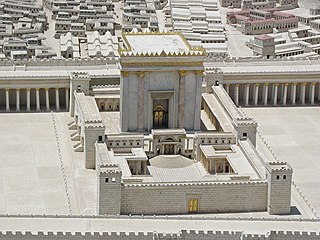
The Second Temple, later known as Herod's Temple, was the reconstructed Temple in Jerusalem between c. 516 BCE and 70 CE. It replaced Solomon's Temple, which is presumed to have been built at the same location before its destruction by the Neo-Babylonian Empire during the Babylonian siege of Jerusalem in c. 587 BCE. Construction on the Second Temple began some time after the Neo-Babylonian Empire was conquered by the Achaemenid Persian Empire; it followed a proclamation by Persian king Cyrus the Great that ended the Babylonian captivity and initiated the return to Zion. In Jewish history, the Second Temple's completion in Persian Judah marks the beginning of the Second Temple period.
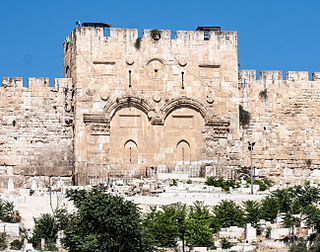
The Golden Gate or Gate of Mercy is the only eastern gate of the Temple Mount, and one of only two Gates of the Old City of Jerusalem that used to offer access into the city from the East side.

The Tower of David, also known as the Citadel, is an ancient citadel located near the Jaffa Gate entrance to the Old City of Jerusalem.
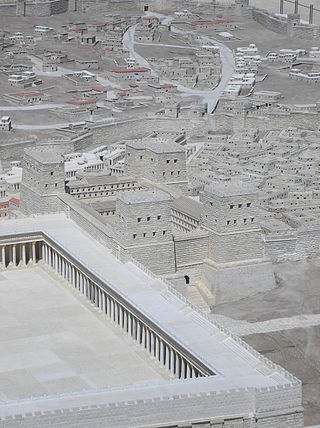
The Antonia Fortress was a citadel built by Herod the Great and named for Herod's patron Mark Antony, as a fortress whose chief function was to protect the Second Temple. It was built in Jerusalem at the eastern end of the so-called Second Wall, at the north-western corner of the Temple Mount.

Al-Marwani Mushalla is an underground vaulted space now used as a Muslim prayer hall by the name of Al-Marwani Mosque, some 600 square yards in area, at the bottom of stairs which lead down from the al-Aqsa Mosque, under the al-Aqsa Mosque, to the base of the southern wall of the enclave of al-Aqsa Mosque in Islamicjerusalem Jerusalem. Al-Marwani Mosque is located under the southeastern corner of the al-Aqsa Mosque compound, 12.5 m (41 ft) below the courtyard, and feature twelve rows of pillars and arches. In December 1996 the Waqf converted the area into a prayer hall by adding lights and floor tiles, and renamed it the El-Marwani Prayer Hall.
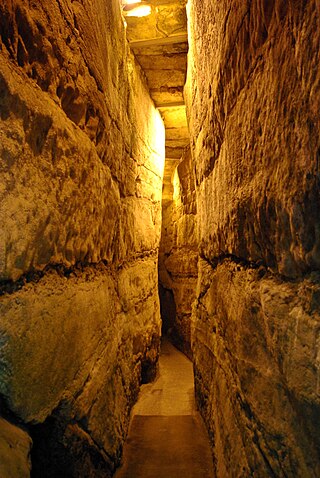
The Western Wall Tunnel is a tunnel exposing the Western Wall slightly north from where the traditional, open-air prayer site ends and up to the Wall's northern end. Most of the tunnel is in continuation of the open-air Western Wall and is located under buildings of the Muslim Quarter of the Old City of Jerusalem. While the open-air portion of the Western Wall is approximately 60 metres (200 ft) long, the majority of its original length of 488 metres (1,601 ft) is hidden underground. The tunnel allows access to the remainder of the Wall in a northerly direction.

The Acra, with the meaning of "stronghold", was a place in Jerusalem thought to have had a fortified compound built by Antiochus Epiphanes, ruler of the Seleucid Empire, following his sack of the city in 168 BCE. The name Acra was also used at a later time for a city quarter probably associated with the by-then destroyed fortress, known in his time to Josephus as both Acra and "the lower city". The fortress played a significant role in the events surrounding the Maccabean Revolt, which resulted in the formation of the Hasmonean Kingdom. The "upper city" was captured by Judas Maccabeus, with the Seleucid garrison taking refuge in the "Acra" below, and the task of destroying this last enemy stronghold inside Jerusalem fell to Simon Maccabeus surnamed Thassi. Our knowledge about the Acra is based almost exclusively on the writings of Josephus, which are of a later date, and on the First and Second Books of Maccabees, which were written not long after the described events.

The Foundation Stone, or the Noble Rock is the rock at the center of the Dome of the Rock in Jerusalem. It is also known as the Pierced Stone, because it has a small hole on the southeastern corner that enters a cavern beneath the rock, known as the Well of Souls.

The Huldah Gates were one of the Gates of the Old City of Jerusalem leading into the Jerusalem Temple compound in the Hasmonean period and were named as such in the Mishnah. The term is currently being used for the remains of two later sets of gates, the Triple Gate and the Double Gate, known together as the Huldah Gates, built as part of the much extended Herodian Temple Mount, situated in Jerusalem's Old City. Both sets of gates were set into the Southern Wall of the Temple compound and gave access to the Temple Mount esplanade by means of underground vaulted ramps. Both were walled up in the Middle Ages.
Solomon's Porch, Portico or Colonnade, was a colonnade or cloister, located on the eastern side of the Temple's Outer Court in Jerusalem, named after Solomon, King of Israel, and not to be confused with the Royal Stoa, which was on the southern side of Herod's Temple.
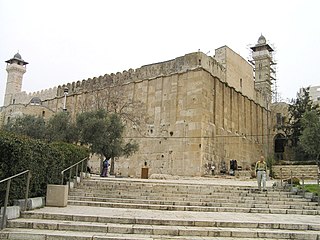
Herodian architecture is a style of classical architecture characteristic of the numerous building projects undertaken during the reign of Herod the Great, the Roman client king of Judea. Herod undertook many colossal building projects, most famously his reconstruction of the Temple in Jerusalem. Many of his structures were built upon comparable, previous Hasmonean buildings and most of his have, in their turn, vanished as well.
Leen Ritmeyer is a Dutch-born archaeological architect who currently lives and works in Wales, after having spent 22 years (1967–89) in Jerusalem.

Jerusalem during the Second Temple period describes the history of Jerusalem during the Second Temple period, from the return to Zion under Cyrus the Great to the siege and destruction the city by Titus during the First Jewish–Roman War. During this period, which saw the region and city change hands several times, Jerusalem was the center of religious life for all Jews; even those who lived in the diaspora prayed towards Jerusalem on a daily basis and made pilgrimages during religious festivals. Under Hasmonean and Herodian rule, Jerusalem served as a royal capital and the seat of all major national institutions. In Jerusalem, the Pharisees of Second Temple Judaism developed into the Tannaim and Judaism's post-Exilic religious identity as it continues today, and the Hebrew Bible was perhaps canonized, although exactly when this occurred remains disputed. It was also in Jerusalem during the later stages of this period that Christianity was born.
The Jerusalem Water Channel is a central drainage channel of Second Temple Jerusalem, now an archaeological site in Jerusalem.
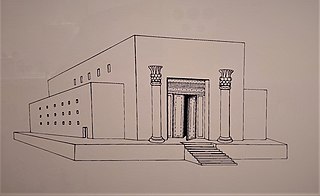
Solomon's Temple, also known as the First Temple, is a Temple in Jerusalem believed to have existed between the 10th and 6th centuries BCE. Its presumed existence is largely based on narratives in the Hebrew Bible, in which it was commissioned by biblical King Solomon before being destroyed during the siege of Jerusalem by King Nebuchadnezzar II of the Neo-Babylonian Empire in 587 BCE. Although most modern scholars agree that the First Temple existed on the Temple Mount in Jerusalem by the time of the Babylonian siege, there is significant debate over the date of its construction and the identity of its builder.

The Southern Wall is the retaining wall of the Temple Mount at the southern end. It was built during King Herod's expansion of the Temple Mount platform southward on to the Ophel.

Herod's Palace at Jerusalem was built in the last quarter of the 1st century BC by Herod I the Great, King of Judea from 37 BC to 4 BC. It was the second most important building in Jerusalem, after the Temple itself, in Herod's day and was situated at the northwestern wall of the Upper City of Jerusalem. Herod lived in it as a principal residence, but not permanently, as he owned other palace-fortresses, notably at Masada, Herodium and Caesarea Maritima. Nothing remains of the Jerusalem Palace today except for portions of the surrounding wall-and-tower complex, much altered and generally known as "the Citadel". The site of the former palace is now occupied by the Tower of David Museum, a police station, and a former Turkish barracks/prison known as the Kishle.

Several kinds of archaeological remnants of the Jerusalem Temple exist. Those for what is customarily called Solomon's Temple are indirect and some are challenged. There is extensive physical evidence for the temple called the Second Temple that was built by returning exiles around 516 BCE and stood until its destruction by Rome in the year 70 CE.


















